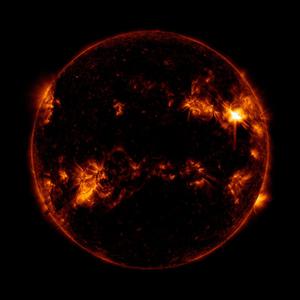Glossary term: 太阳耀斑
Description: 太阳耀斑是太阳某一部分的短暂增亮。
太阳周围有一个复杂的磁场。有时,这个磁场会变得不稳定,发生结构的改变并释放出大量储存的能量。这会导致太阳大气局部加热,并使光球层的一小部分变亮。这也会导致巨量的粒子流被抛向太空(称为日冕物质抛射)。
大多数太阳耀斑对太阳亮度的改变是人眼难以察觉的,只有用太阳望远镜或监测太阳的太空望远镜才能看到。
如果太阳抛射的日冕物质离地球足够近,与地球磁场相互作用,就会引起地磁暴。
其他恒星也会产生耀斑(称为恒星耀斑),但由于我们看到的恒星是光点,只能看到恒星整体短暂变亮。
Related Terms:
See this term in other languages
Term and definition status: The original definition of this term in English have been approved by a research astronomer and a teacher The translation of this term and its definition is still awaiting approval
The OAE Multilingual Glossary is a project of the IAU Office of Astronomy for Education (OAE) in collaboration with the IAU Office of Astronomy Outreach (OAO). The terms and definitions were chosen, written and reviewed by a collective effort from the OAE, the OAE Centers and Nodes, the OAE National Astronomy Education Coordinators (NAECs) and other volunteers. You can find a full list of credits here. All glossary terms and their definitions are released under a Creative Commons CC BY-4.0 license and should be credited to "IAU OAE".
If you notice a factual or translation error in this glossary term or definition then please get in touch.
Related Media
太阳耀斑
Credit: NASA/SDO credit link
License: PD Public Domain icons









